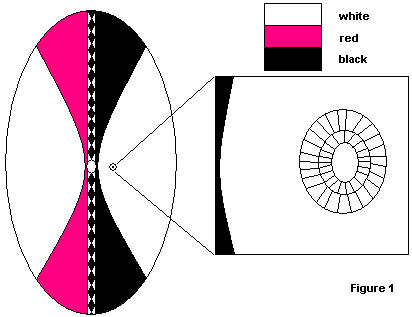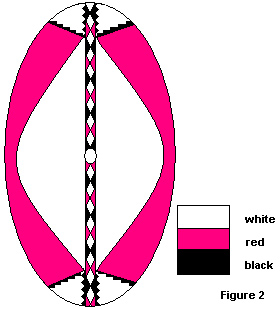 Maasai shield designs allowed knowledgeable observers to assimilate at a glance considerable information about the shield’s bearer including his age, tribal location, lineage, and perhaps even relative military prowess.
Maasai shield designs allowed knowledgeable observers to assimilate at a glance considerable information about the shield’s bearer including his age, tribal location, lineage, and perhaps even relative military prowess.
The shields were constructed from buffalo hide that were scraped free of hair prior to the application of any paint. Three primary colors were employed: red, white, and black, though grey was occasionally substituted for black. Red was derived from blood or fruit juice, black from charred gourd, and grey from ground cattle bones.
Rinderpest epidemic, drought, small pox, and civil war devastated the Maasai population in the 1890s, resulting in a fragmentation both of the group associations represented by many shield devices and also in collective knowledge of the same. Nonetheless a few broad generalizations regarding shield design can still be made.
Firstly, the shields were almost always divided into two halves by a perpendicular band, the es segira, intended to represent a stylized string of cowrie (mollusk) shells.
One half of the shield typically features broad red bands that make reference to the shield bearer’s place of origin. Black bands on the opposite shield half speak to the bearer’s lineage though these are present only if the bearer could claim descension from a group predominant in his area of origin. Christopher Spring writes that “the practical reason for this selective display [was to] to remind those who were not members of the predominant sub-clan to stay in line and, for example, not to expect too large a share of booty after raids.”
 These black bands became increasingly less common in the early 1900s and were often replaced by red bands symmetrical to those found on the opposite shield half.
These black bands became increasingly less common in the early 1900s and were often replaced by red bands symmetrical to those found on the opposite shield half.
Two additional features of Maasai shield design are of special note to wargamers: First, a small flower-like motif was often added to a warrior’s shield after performance of a conspicuous act of bravery (see Figure 1).
Just as TSATF describes situations under which a British soldier may qualify for receipt of the VC, so could similar provisions be made for the Maasai with the motif added to the recognized warrior’s shield and the figure awarded combat bonuses in subsequent games.
Secondly, various designs were often added to the top or bottom of a warrior’s shield to denote membership in different military affiliations (see Figure 2).
Reference:
Christopher Spring, 1993, African Arms and Armour, London.
Back to The Heliograph # 137 Table of Contents
Back to The Heliograph List of Issues
Back to Master Magazine List
© Copyright 2003 by Richard Brooks.
This article appears in MagWeb.com (Magazine Web) on the Internet World Wide Web.
Other articles from military history and related magazines are available at http://www.magweb.com